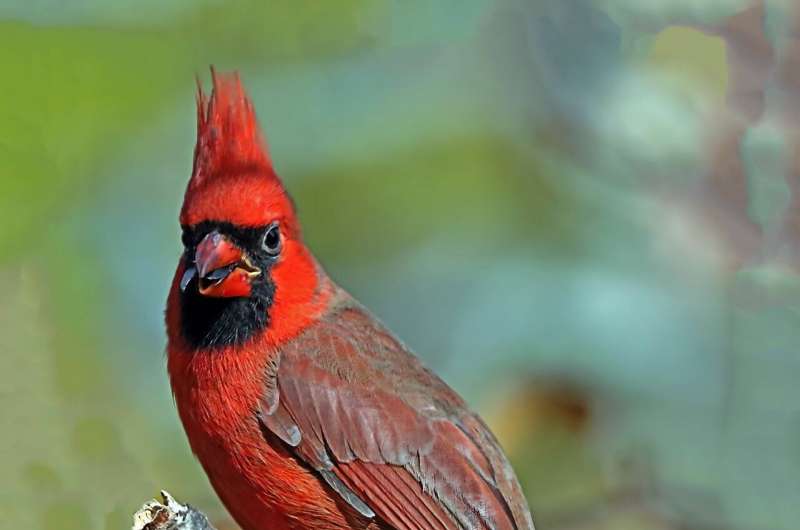
In 1970, there were approximately 10 billion birds in North America. Now, there are around 7 billion, representing a loss of over a quarter of the continent’s birds.
Of the 3 billion birds lost, 90% come from just 12 families, all various types of songbirds: a broad suborder of perching birds including everything from painted buntings, dainty and colorful with a melodic whistle, to the common crow, large and black with a scratchy caw.
Songbirds face a variety of threats, with outdoor cats, building collisions and habitat destruction among the most pervasive and well understood factors in their decline. A new threat—songbird trafficking—has emerged, though, and Texas is thought to be a big part of the equation.
“It’s so important for us in Texas to care about [songbirds], because we’re the pathway that they all travel through [during migration],” said Chris Corpus, the director of conservation at the Dallas Zoo. “If we’re not doing something here, it’s going to affect songbirds in Ohio, it’s going to affect songbirds in Illinois. … We’re the gatekeeper, so it’s important for us to take action here.”
Songbird trafficking in North America has only recently come under the microscope, according to experts including Mike Kreger, the co-chair of the Association of Zoos and Aquariums’ initiative for the conservation of North American songbirds.
Around five years ago, Kreger and his partner Sara Hallager, the curator of birds at the Smithsonian National Zoo, thought “the time was right” to begin such an initiative under the Association of Zoos and Aquariums’ Saving Animals from Extinction umbrella. The North American songbird conservation program, known as SAFE NAS, now has over 80 members. Those participants, including the Dallas Zoo, commit resources to save the birds almost anyone can see in their backyard, and trafficking is one of seven of the program’s focus areas encompassing all manner of population threats.
“We are working very hard to get the baseline information,” said Kreger, who is also vice president of conservation at the Columbus Zoo. “And hopefully, in the near future, we’ll understand the trade better and its impacts, and we’ll be able to make some policy decisions.”
Experts understand why songbirds—including many native to Texas and that travel through Texas—are trafficked and where they end up, but the extent of the issue is still being researched.
Captured birds are used in singing competitions. It’s a popular practice in many cultures in which wild-caught songbirds, as opposed to birds bred in captivity, are the preferred competitors, according to Kreger. Authorities such as the U.S. Fish and Wildlife Service and SAFE’s researchers have found North American songbirds for sale in pet stores in foreign countries, Corpus said, and domestically on Facebook and Craigslist.
These practices violate multiple century-old conservation laws, including the Migratory Bird Treaty Act and the Lacey Act. The treaty prohibits the capture, trade, transport, possession and killing of migratory birds, among other things, and the Lacey Act prohibits the trade of any illegally taken wildlife or plant. Law enforcement agencies have made major arrests for violations of these laws, and, according to Corpus, they are actively investigating many more cases.
In August, U.S. Fish and Wildlife arrested and charged six men in Houston in connection with songbird trafficking, confiscating over 300 illegally trapped songbirds. In February, a man prosecutors referred to as “one of New York’s finch-smuggling kingpins” was sentenced to a year and a day in prison for trying to sneak songbirds through the JFK airport in New York by stuffing them in hair curlers. He had previously pleaded guilty to a similar crime in 2018.
Kreger said he has noticed law enforcement action being taken against songbird trafficking, but quantifying the extent, and whether it’s getting more common, is difficult. Though songbird populations, including birds known to be the favorites of traffickers, are declining, it’s hard to parse how much of that is trafficking and how much comes from the myriad other threats birds face.
“It’s hard to dig up the numbers, because Texas Parks and Wildlife has some numbers, U.S. Fish and Wildlife has numbers,” Corpus said. “When you start to compare their numbers, you see small batches of 10s and 30s here and there, but it all starts to add up to thousands.”
In Southeast Asia, where bird singing competitions are very common, the damage done by songbird trafficking has been well known and understood among conservation and wildlife enforcement groups for decades, according to Corpus. Then, around the turn of the century, they started noticing songbirds native to the Americas popping up in these competitions, prompting conservation groups to look into songbird trafficking at home in the U.S.
The Convention on International Trade in Endangered Species of Wild Fauna and Flora is an international agreement signed by 183 parties to ensure that illegal trade does not harm wildlife populations. In December, CITES will host a workshop gathering member nations to piece together “the scale and scope” of songbird trafficking worldwide. In 2021, international researchers across disciplines introduced the Songbirds in Trade Database—which provides information on nearly 7,000 songbird species’ relationship to illegal trade—to support CITES.
According to the dataset, several beloved Texas songbirds, like painted buntings and northern cardinals, are at moderate to high conservation concern due to trade. The painted bunting is one of just a handful of species with observed population decline due to trade even with limited data available.
The American Bird Conservancy, a conservation organization, works with a nonprofit in Brazil to educate local police on identifying trafficked birds; SAFE NAS has researchers trying to figure out how to give songbird traffickers an alternate livelihood.
Still, it’s just as important to combat trafficking at home. Texas acts as a funnel from North America into South America and vice versa during songbird migration. Two billion birds passed through Texas in fall, representing a quarter of all migratory birds in the U.S.
“Poachers are no dummies. They know that if you set up these traps at the right time of year, when all these birds are going through, they’re going to be able to catch them,” Corpus said.
Law enforcement agents have found songbird traps in North Texas, Corpus said. Poachers use box traps, nets and glue spread onto branches to catch songbirds, and the consequences are deadly. Around 80% of songbirds that are captured die, according to Corpus, both from the traps themselves and the stress of captivity.
Those who find a trap, can report it to state and federal wildlife agencies, but there are more effective ways to help.
“With songbirds, unlike so many other species, you can tell people how you can take actions in your own backyard,” Kreger said. “People feel ownership of the birds that spend some part of their annual lifecycle in their own backyards, so you can do a lot more for birds directly.”
Kreger noted that many people who make up the market for trafficked songbirds—those who keep them as pets or to compete in singing competitions, for example—don’t know how detrimental those practices can be for the birds, so education is a huge component of combating the trade.
People can also support bird populations by turning their lights off at night, keeping their cats indoors and growing native plants, thereby contributing to a healthy habitat for songbirds, Kreger said.
“They’re beautiful, and they’re wonderful to see and to hear in the landscape, but without songbirds, we would lose some of our habitats that we all love, our grasslands, our wetlands, our forests,” Corpus said. “These birds are vital for spreading seeds, for helping pollinate things, or helping manage the insects that are in these habitats. Without these birds, our habitats would change dramatically.”
2023 The Dallas Morning News. Distributed by Tribune Content Agency, LLC.
Citation:
Protected Texas songbirds show up in pet stores abroad, due to elusive trafficking industry (2023, November 27)
retrieved 27 November 2023
from https://phys.org/news/2023-11-texas-songbirds-pet-due-elusive.html
This document is subject to copyright. Apart from any fair dealing for the purpose of private study or research, no
part may be reproduced without the written permission. The content is provided for information purposes only.






